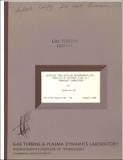Detailed time resolved measurements and analysis of unsteady flow in a transonic compressor
Author(s)
Ng, Wing
Download915605535.pdf (8.989Mb)
Other Contributors
Massachusetts Institute of Technology. Department of Mechanical Engineering
Metadata
Show full item recordAbstract
Detailed time and space resolved measurements for a transonic compressor stage have been completed in the MIT Blowdown Compressor Facility. The stage studied was a new first stage for a NASA two-stage machine which incorporated low-aspect-ratio blading. This rotor has an inlet hub/tip ratio of 0.375, aspect ratio of 1.56 and an inlet relative Mach number of 1.38. The purposes of the test were to compare the results obtained by the Blowdown technique with those found by steady state testing at NASA Lewis Research Center, and to provide new time resolved data on the blade-to-blade flow in the rotor and stator. Data were obtained by surveys with a five diaphragm high frequency response probe and by tip casing transducers.
The stage was tested at 100% design speed. Time resolved estimates of efficiency were obtained by direct measurement of stagnation pressure together with calculation of stagnation temperature by the Euler equation using measured tangential flow Mach number. Test results showed that the rotor achieved an adiabatic efficiency of 0.895 at a total pressure ratio of 1.677. The stage achieved an adiabatic efficiency of 0.862 at a total pressure ratio of 1.658. Corrected mass flow at design was measured to be 33.3 Kg/s with respect to air. Time averaged flow quantities in general agree very well with results from steady state tests at NASA Lewis Research Center. A significant difference was observed in the variation of efficiency with radius, with a low efficiency region near mid-span not observed in the steady state testing. Moreover, the measured rotor efficiency in the "core flow" between the blade wakes for the supersonic region is lower than can be explained by normal shock losses. Large streamwise vorticity is observed at the blade trailing edge in the inner half of the annulus, which may be associated with shock termination at the sonic radius.
Description
Includes bibliographical references
Date issued
c1980Publisher
c1980
Series/Report no.
GT & PDL report ; no. 150